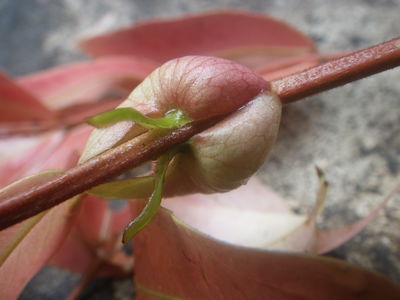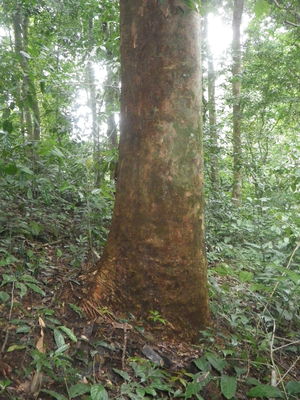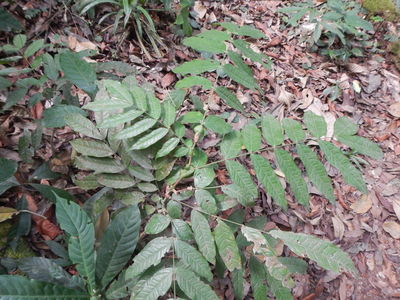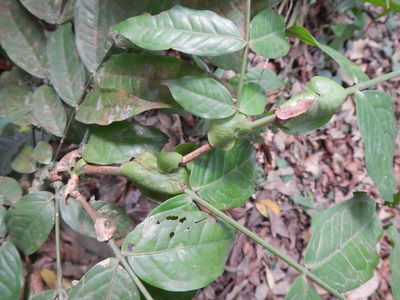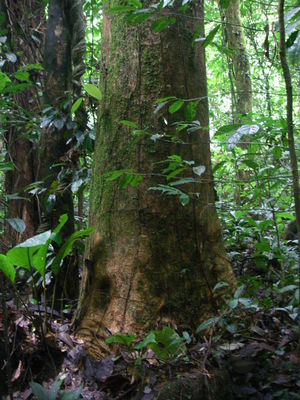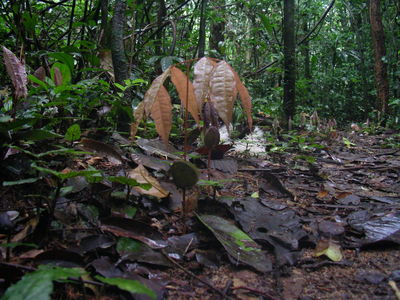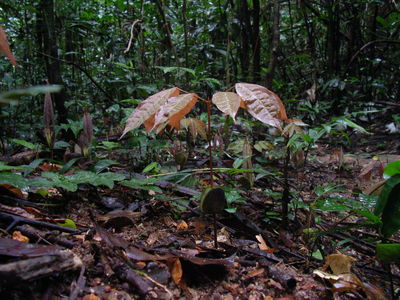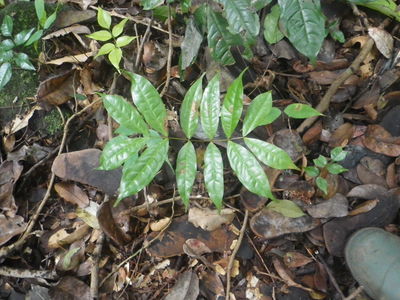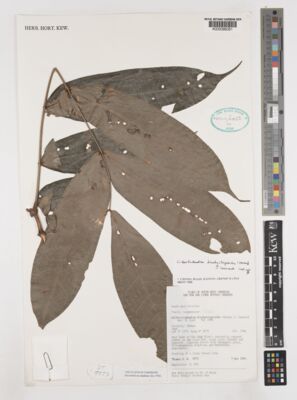van der Burgt, X.M., Mackinder, B.A., Wieringa, J.J. et al. The Gilbertiodendron ogoouense species complex (Leguminosae: Caesalpinioideae), Central Africa. Kew Bulletin 70: 29. DOI https://doi.org/10.1007/s12225-015-9579-4
-
Morphology
General
Habit
-
Tree, to c. 45 m tall
-
Morphology
Trunk
-
Trunk straight, cylindrical, to 93 cm diam. Bark light yellowish brown, exfoliating in small and thin papery flakes
-
Morphology
Twigs
-
Twigs sparsely puberulent, hairs to 0.3 mm long
-
Morphology
Leaves
Stipules
-
Stipules in pairs, free; reniform part persistent, a pair of stipules strongly inrolled towards each other, 10 – 30 × 7 – 20 × 3 – 10 mm, sparsely puberulent both sides, hairs to 0.1 mm long; lanceolate part of stipule early caducous, 5 – 12 × 1 – 2 mm
-
Morphology
Leaves
-
Leaves paripinnate, to 35 × 15 cm; petiole 4 – 10 mm long, 2 – 4 mm diam., puberulent, hairs to 0.2 mm long; leaf rachis 6 – 22 (– 28) cm long, puberulent, hairs to 0.2 mm long, stipels absent; petiolules 1 – 2 mm long, puberulent, hairs to 0.2 mm long
-
Morphology
Leaves
Leaflets
-
Leaflets papery, opposite, 5 – 10 (– 11) pairs, upper pair oblanceolate, other pairs narrowly elliptic to elliptic, 3 – 9 (– 11) × 1 – 3 (– 5) cm (to 23 × 7 cm on juvenile trees), glabrous above, glabrescent or glabrous below, smooth and dull to somewhat glossy both sides, lower surface same colour or slightly lighter, midrib prominent below, midrib sparsely puberulent to glabrescent both sides, hairs to 0.2 mm long; 7 – 10 pairs of secondary veins; leaflet base cuneate to obtuse, oblique; apex acuminate and mucronate, acumen 0 – 1 cm long
-
Morphology
General
Glands
-
Glands 0 – 1 per leaflet, at the proximal margin 5 – 16 mm from the apex and at the distal margin 2 – 10 mm from the petiolule
-
Morphology
Reproductive morphology
Inflorescences
-
Inflorescence a congested, axillary or terminal cluster of 1 to several panicles, to 9 cm long, densely puberulous, hairs to 0.5 mm long, internodes 4 – 10 mm long; lateral axes to 7 cm long, with 10 – 12 flowers per cm
-
Morphology
Reproductive morphology
Flowers
-
Flowers fragrant, floral bract inserted at base of pedicel, caducous, ovate, 3 – 4 × 2 mm, densely puberulous on both sides, centre inside glabrous, hairs to 0.3 mm long; pedicel 10 – 25 mm long, densely puberulous, dense light-coloured hairs to 0.1 mm long mixed with dense dark brown hairs to 0.4 mm long; bracteoles 2, elliptic, light reddish brown outside, whitish inside, 5 – 6 × 4 – 5 mm, densely puberulous outside, dense light-coloured hairs to 0.1 mm long mixed with dense dark brown hairs to 0.4 mm long; sparsely puberulous inside, centre inside glabrous; receptacle 1 mm high, 2 mm diam. at top, outside glabrous apart from two patches of hairs at adaxial and abaxial side; sepals 5, white, glabrous, narrowly triangular, 2 – 3 × 1 mm, apex acute; petals 5, alternate to sepals, white, glabrous; adaxial petal claw 4 – 5 mm long, blade bilobed, 5 – 6 mm high × 10 – 15 mm wide; the other 4 petals 2 × 0.7 mm, apex acute; stamens 3, inserted alternate to the 4 small petals; filaments white, glabrous, 10 – 12 mm long; anthers glabrous, 2 mm long; 6 staminodes, filiform, to c. 1 mm long, inserted on a staminodal tube c. 0.8 mm long, tapering towards the top, encircling ¾ of the ovary stipe opposite the large petal; ovary light green, 2.5 × 1 × 0.5 mm, 4 – 5 ovules, margins densely hirsute, hairs to 0.8 mm long, sides glabrous; stipe 1 mm long; style 10 – 14 mm long, lower part sparsely hirsute, upper part glabrous, stigma capitate
-
Morphology
Reproductive morphology
Fruits
-
Fruits oblong-rectangular, brown, dull, glabrous, 0 – 5-seeded, 12 – 19 × 5 – 7 cm, valve 3 mm thick, beak 3 – 5 mm long, sutures not winged; 1.5 – 2 longitudinal ridges running from the base to the apex, parallel to and at 0.5 – 2.5 cm distance to the upper suture
-
Seedling
-
Seedlings: hypocotyl 3 – 7 cm long, epicotyl 11 – 13 cm long; first two leaves opposite, petiole and rachis 4 – 6 cm long, petiolules 1 mm, 2 – 3 pairs of leaflets 7 – 10 × 2 – 3 cm (in reality 3 – 4 pairs of leaflets, lowest pair reduced to < 3 mm long)
-
Distribution
-
Gilbertiodendron brachystegioides occurs in Cameroon, Equatorial Guinea and Gabon (Map 14). The species occurs close to the Nigerian border, but is not mentioned in the book Trees of Nigeria by Keay (1989).
-
Ecology
-
Gilbertiodendron brachystegioides occurs in evergreen rain forest on well-drained soil, at 0 – 700 m asl.
-
Conservation
-
Gilbertiodendron brachystegioides is assessed here according to IUCN criteria as Least Concern (Table 1).
-
Note
-
However, since this is the only obvious difference between G. brachystegioides specimens from Cameroon and those from Gabon, and since there is considerable overlap, the Gabon specimens may not represent a different taxon. On the other hand some recent molecular studies show a general pattern of a genetic discontinuity that lies in Northern Gabon and seems to separate several Cameroonian populations or species from Gabonese ones (Peccoud et al. 2013; Hardy et al. 2014). Presently there are eight flowering specimens from Cameroon, but there are only three flowering collections from Gabon (Groulez 1109, Wilks 1086, 1600) and one from Equatorial Guinea (Wilks 3582). Before a decision can be made, more flowering specimens should be collected and studied, while a phylogenetic study may reveal if also in this case such a genetic discontinuity is present. A phylogenetic study by Estrella et al. (2014) suggests that the two Cameroon specimens Burgt 801 and Wieringa 2242 are conspecific and the two collections from Gabon Breteler 14983 and Wieringa 6226 as well; however, it is not clear from that study whether these four specimens represent one or two taxa.
The most common number of pairs of leaflets on fertile specimens from Cameroon is 7, with an average of 6.9. In fertile specimens from Gabon the most common number of pairs of leaflets is 10, with an average of 8.8 (Table 4). The two known specimens from Equatorial Guinea have only one leaf each, which is too few to include in the analysis. This is the only obvious difference between G. brachystegioides specimens from Cameroon and those from Gabon. Specimens from Cameroon often have larger leaflets compared to those from Gabon, but some specimens from Cameroon have leaflets just as small as those from Gabon. For example, the flowering specimen Mildbraed 7777 (K) from Cameroon has leaflets similar in size to the specimens from Gabon, but the number of pairs of leaflets on Mildbraed 7777 is 5 – 7 (– 8); similar to the other specimens from Cameroon.
Gilbertiodendron brachystegioides is characterised by its stipules: a pair of stipules is strongly inrolled towards each other (Fig. 17). Within the G. ogoouense species complex, this type of stipules is otherwise only seen in G. ebo and sometimes in G. minkebense and G. ngouniense, but in these species the leaflets occur in fewer pairs. Saplings of G. brachystegioides have been collected many times, presumably because the stipules and young leaves are conspicuous.



